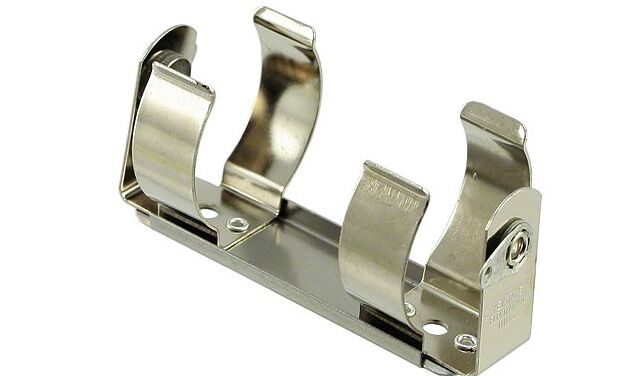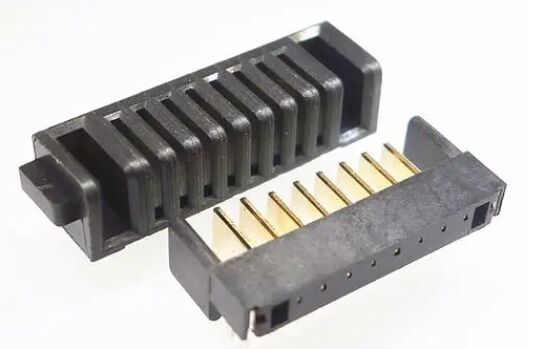By Texas Instruments 170
A battery holder refers to a device or interface for installing a battery. It provides a fixed location and connection point to insert or install the battery into the device and ensures the electrical connection and mechanical fixation between the battery and the device. Battery holders usually have notches or slots that match the size and shape of the battery to ensure proper fit and positioning.

A clip is a device used to hold a battery in place. It is usually made of spring steel sheet and has a certain degree of elasticity. The clips grip the battery and provide a mechanical hold to ensure a secure installation of the battery in the device. Clips usually have an open and closed design, making battery insertion and removal easier.
Contacts are metal or alloy parts used to make contact with the battery. These are located at the connection point of the battery holder or clip and make contact with the positive and negative terminals of the battery. The contacts are usually made of a material with good electrical conductivity, such as copper, brass or steel, to ensure a good electrical connection. Contacts can be in the form of metal shrapnel, pin connectors, contact sheets, etc. to accommodate batteries of different types and sizes.Battery Holders, Clips and Contacts
Ⅰ. Types and characteristics of battery holders
1. Pin seat: The pin seat uses pins or pins to fix the battery and provide reliable mechanical fixation. Pin holders are suitable for some applications that require a high degree of safety and protection, they ensure that the battery will not loosen under vibration or shock conditions.
2. Resilient mounts: Resilient mounts use rubber or elastic material to provide retention and electrical contact. They are suitable for some special shapes or sizes of batteries, and applications that require shock absorption and shock resistance. The elastic seat has good shock resistance and high reliability.
3. Spring seat: Spring seat is a common type of battery seat. It uses a spring to provide pressure and hold on the battery, ensuring electrical contact between the battery and the seat. Spring mounts are available for a wide variety of battery sizes and shapes, and feature good adaptability and easy insertion and removal.
4. Screw seat: The screw seat uses screws or nuts to fix the battery to ensure a stable mechanical connection and electrical connection. Screw mounts are suitable for larger sized batteries and applications that require a higher level of fastening. They provide reliable holding force and shock resistance.
5. Blade seat: The blade seat uses metal blades or contact pieces to provide connection and fixation of the battery. Insert seat can provide high electrical contact force, suitable for some applications requiring higher current transmission. Insert holders generally have better reliability and stability.Battery Management
Ⅱ. Application field of battery holder
1. Communication equipment: Communication equipment such as wireless communication base stations, radio frequency equipment, and network equipment usually use battery holders as the connection interface of the battery, so as to replace the battery and maintain the continuous power supply of the equipment.
2. Consumer Electronics: Battery holders are widely used in consumer electronics, such as mobile phones, portable audio equipment, handheld game consoles, digital cameras, etc. They facilitate easy battery replacement and charging, making these devices flexible to use and mobile.Battery Management Linear 1-cell Li-Ion Charger
3. Automotive electronics: In the field of automotive electronics, battery holders are often used in car keys, remote controls, and on-board equipment. The use of the battery holder facilitates battery replacement and ensures the normal operation of these devices.
4. Industrial equipment: Battery holders are often used in industrial equipment for battery power or backup power. For example, wireless communication equipment, security equipment, measuring instruments, etc. often use a battery holder as a power interface for battery replacement or backup power connection.
5. Portable medical equipment: Many portable medical equipment, such as portable monitors, medical devices, and medical rescue equipment, usually use battery holders as the connection interface for batteries.
6. Wearable devices: With the popularity of wearable devices, battery holders are widely used in smart watches, smart glasses, fitness trackers and other devices. The battery holder provides convenient battery installation and charging interface to meet the power needs of these devices.
Ⅲ.Common contact materials
Contacts are metal or alloy materials used to make contact with the battery. Contact materials are widely used in electronic devices, and their selection depends on the requirements of a specific application, including current transfer capability, corrosion resistance, contact lifetime, environmental conditions, etc. Common contact materials are:
1.Steel: Steel is a common contact material with high strength and mechanical stability. It is typically used in applications requiring high strength and durability, such as automotive battery connectors, industrial equipment, etc. Steel contacts can have surface treatments such as silver plating to improve their electrical conductivity and corrosion resistance.Battery Management Li-Ion Charger
2. Nickel Alloy: Nickel alloy has good corrosion resistance and high temperature performance, and is suitable for special environments or applications requiring high reliability.
3. Copper: Copper is a commonly used contact material with good electrical and thermal conductivity. It is highly conductive and provides a low resistance electrical connection. Copper contacts are often surface treated, such as gold or silver plated, to improve their corrosion resistance and contact life.
4. Phosphor Bronze: Phosphor bronze is an alloy of copper, tin and phosphorus, which has good elasticity and electrical conductivity. It is often used in high-precision and high-reliability applications, such as communication equipment, computer interfaces, etc. Phosphor bronze contacts provide long contact life and a stable electrical connection.
Ⅳ. Working principle of battery holder
1. Insulation and safety protection: The battery holder may have insulating materials and structures to prevent short circuits and safety hazards between the battery and equipment or other circuits. Some battery holders may also integrate safety protection functions, such as over-current protection, over-temperature protection, over-discharge protection, etc., to protect the safe use of the battery.
2. Mechanical stability: In addition to providing an electrical connection, the battery holder also ensures the mechanical stability of the battery in the device. It should provide enough holding force that the battery will not loosen or fall out during use.
3. Mechanical fixation: The battery holder provides a fixed position and structure for installing the battery. Typically, battery holders have notches or slots that fit the size and shape of the battery, ensuring that the battery fits and sits properly.
4. Electrical connection: The contact point of the battery holder is connected to the positive and negative poles of the battery. Contact materials are usually metals or alloys that conduct electricity well, such as copper, brass, or steel. These contacts establish an electrical connection with the battery, allowing electricity to flow from the battery to the device.
5. Stable current transmission: The contact point of the battery holder should provide good electrical conductivity to ensure the stability and low resistance of current transmission. High-quality contact point materials and the quality of the contact surface are critical to maintaining a stable electrical connection.
Ⅴ. How to install the battery holder
1. Spring clip installation: Some battery holders are designed with spring clips, so that the battery can be fixed on the seat by clamping force. This installation method is convenient for quick battery replacement and fixing, and is suitable for some applications that require frequent battery replacement.
2. Welding installation: In some applications, the battery holder needs to be connected to the circuit board or other equipment by welding. This type of installation is usually used in scenarios that require a stronger and more stable connection. Soldering installation needs to weld the soldering legs of the battery holder with the corresponding connection points to ensure reliable electrical connection.
3. Plug-in installation: This is the most common installation method, which is suitable for the design of the battery holder with a slot or notch. Batteries can be inserted directly into the slots in the battery holder, ensuring correct polarity connection.
4. Screw installation: For some large batteries or applications that require additional fixing force, the battery holder can be installed with screws or nuts. The screw-type mounting provides stronger mechanical fixing force to ensure the stable installation of the battery in the device.

Frequently Asked Questions
1. What are the safety protection measures provided by the battery holder?
Over-temperature protection: Some battery holders may have an over-temperature protection function that monitors the temperature of the battery or battery holder, and when the temperature exceeds a set threshold, measures are taken to prevent overheating, such as cutting off the circuit or reducing the charging rate.
Over-current protection: The battery holder may have an over-current protection function. When the current exceeds the safe range, the circuit will be automatically cut off to avoid overload and battery damage.
Short-circuit protection: The battery holder can have a short-circuit protection function. When the battery holder is short-circuited, the circuit will be cut off to prevent safety risks caused by excessive current.
Flip protection: Some battery holders have a flip protection function, which can detect the correct insertion direction of the battery. When the battery is reversed, it will prevent the use of the battery holder to avoid short circuit and damage.
2. Factors affecting the durability of the battery holder?
The design structure of the battery holder shall take into account the stable installation of the battery and the stability of the contact points. Reasonable structural design can disperse stress, provide sufficient support and fixing force, and reduce damage to battery holders and contacts caused by battery plugging and unplugging. Frequent insertion and removal of batteries and the way they are used can also affect the durability of the battery holder. Proper and careful insertion and removal of batteries, avoiding excessive force or undue stress, will help extend the life of the battery holder.
3. Can the battery holder provide a good electrical connection?
The battery holder provides a good electrical connection. The contacts of the battery holder are the parts that make contact with the positive and negative terminals of the battery. Contacts are usually made of a metal or alloy with good electrical conductivity, such as copper, brass or steel. Their design shape and structure are optimized to ensure good contact with the battery and provide a low resistance electrical connection. Keeping the battery holder clean and maintained is also key to ensuring a good electrical connection. The design of the battery holder should match the circuit design of the device.
4. What are the ways in which the battery holder can provide sufficient mechanical holding force?
Screws or Fixtures: Some battery holders may use screws or other fixtures to provide additional mechanical retention. By connecting the battery holder with other parts of the device, the stability and reliability of the mechanical fixation can be increased.
Spring or Clamp Design: Battery holders may use springs or clamps to provide mechanical retention. The springs apply just the right amount of pressure to ensure the battery stays securely in place.
Structural design: The structural design of the battery holder should take into account factors such as the size, shape and weight of the battery to ensure good mechanical fixation.